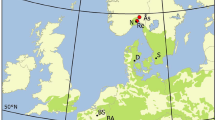Abstract
Leaves from forest-grown sugar maple (Acer saccharum Marsh) and yellow birch (Betula allegheniensis Britt.) trees were analyzed for four tannin measures (hydrolyzable and condensed tannins, total phenolics, and protein binding) at three times during the growing season. Fifteen-year-old half-sib sugar maples from four provenances, representing the geographical extremes of the sugar maple range and growing in a common garden, were examined for the same traits. We found no significant geographic or seed source component to variation in three of the four tannin measures. We found significant seasonal changes in both birch and maple leaf tannins. Withincanopy leaf tannin variation tended to obscure differences between trees in maple, but in birches between-tree differences in leaf tannin content were more readily found. We also found a significant negative correlation between leaf protein binding capacity and leaf wet weight.
Similar content being viewed by others
References
Baldwin, I.T., andSchultz, J.C. 1983. Rapid changes in tree leaf chemistry induced by damage: Evidence for communication between plants.Science 221:277–279.
Baldwin, I.T., andSchultz, J.C. 1984. Damage- and communication-induced changes in yellow birch leaf phenolics,in R. Lenner (ed.). Proceedings, 8th Annual Forest Biology Workshop. Utah University Press, Logan, Utah.
Bate-Smith, E.C. 1975. Phytochemistry of proanthocyanins.Phytochemistry 14:1107–1113.
Bernays, E.A. 1981. Plant tannins and insect herbivores: An appraisal.Ecol. Entomol. 6:353–360.
Bridgen, M.R., andHanover, J.W. 1982. Genetic variation in oleoresin physiology of scotch pine.For. Sci. 28:582–589.
Chan, B.G., Waiss, A.C., Jr., andLukefahr, M. 1978. Condensed tannin, an antibiotic chemical fromGossypium hirsutum.J. Insect. Physiol. 24:113.
Coley, P.D. 1983. Herbivory and defensive characteristics of tree species in a lowland tropical forest.Ecol. Monogr. 53:209–233.
Cooley, W.W., andLohnes, P.R. 1971. Multivariate Data Analysis. John Wiley & Sons, New York.
Faeth, S.H. 1986. Indirect interactions between temporally separated herbivores mediated by the host plant.Ecology 67:479–494.
Feeny, P. 1970. Seasonal changes in oak leaf tannins and nutrients as a cause of spring feeding by winter moth caterpillars.Ecology 51:565–581.
Feeny, P.P., andBostock, H. 1968. Seasonal changes in the tannin content of oak leaves.Phytochemistry 7:871–880.
Gregory, R.A. 1980. Annual cycle of shoot development in sugar maple.Can. J. For. Res. 10:316–326.
Hagerman, A.E., andButler, L.G. 1978. Protein precipitation method for the quantitative determination of tannins.J. Agric. Food Chem. 26:809–812.
Lawson, D.L., Merritt, R.W., Martin, M.M., Martin, J.S., andKukor, J.J. 1984. The nutritional ecology of larvae ofAlsophila pometaria andAnisota senatoria feeding on early- and late-season oak foliage.Entomol. Exp. Appl. 35:105–114.
Lester, D.T. 1974. Geographic variation in leaf and twig monoterpenes of Balsam fir.Can. J. For. Res. 4:55–60.
Martin, J.S., andMartin, M.M. 1982. Tannin assays in ecological studies: Lack of correlation between phenolics, proanthocyanidins and protein-precipitating constituents in mature foliage of six oak species.Oecologia 54:205–211.
McCarroll, D.R., andThor, E. 1985. Pectolytic, cellulytic, and proteolytic activities expressed by cultures ofEndothia parasitica, and inhibition of these activities by components extracted from Chinese and American chestnut inner bark.Physiol. Plant Pathol. 26:367–378.
Mooney, H.A., Gulmon, S.L., andJohnson, N.D. 1983. Physiological constraints on plant defenses, pp. 21–36,in P.A. Hedin (ed.). Plant Resistance to Insects. American Chemical Society, Washington, D.C.
Reese, J.C., Chan, B.C., Waiss, A.C., Jr. 1982. Effects of cotton condensed tannin, maysin (corn) and pinitol (soybeans) onHeliothis zea growth and development.J. Chem. Ecol. 8:1429–1436.
Rhoades, D.F. 1983. Responses of alder and willow to attack by tent caterpillars and webworms: Evidence for pheromonal sensitivity of willows, pp. 55–68,in P.A. Hedin, (ed.).Plant Resistance to Insects, American Chemical Society, Washington, D.C.
Schultz, J.C., andBaldwin, I.T. 1982. Oak leaf quality declines in response to defoliation by gypsy moth larvae.Science 217:149–151.
Schultz, J.C., Baldwin, I.T. andNothnagle, P.J. 1981. Hemoglobin as a binding substrate in the quantitative analysis of plant tannins.J. Agric. Food Chem. 29:823–826.
Schultz, J.C., Nothnagle, P.J., andBaldwin, I.T. 1982. Individual and seasonal variation in leaf quality of two northern hardwood tree species.Am. J. Bot. 69:753–759.
Sharik, T.L., andBarnes, B.V. 1976. Phenology of shoot growth among diverse populations of yellow birch (Betula allegheniensis) and sweet birch (B. lento).Can. J. Bot. 54:2122–2129.
Sokal, R.R., andRohlf, F.J. 1969. Biometry. Freeman, San Francisco.
Strauss, S.H., andCritchfield, W.B. 1982. Inheritance of β-pinene in xylem oleoresin of knobcone x Monterey pine.For. Sci. 28:687–696.
Swain, T. 1979. Tannins and lignins, pp. 657–682,in G.A. Rosenthal and D.H. Janzen, eds. Herbivores, Their Interaction with Secondary Plant Metabolites. Academic Press, New York.
Swain, T., andHillis, W.E. 1959. The phenolic constituents ofPrunus domenstica I. The quantitative analysis of phenolic constituents.J. Sci. Food Agric. 10:63–68.
Wargo, P.M. 1972. Defoliation-induced chemical changes in sugar maple roots stimulate growth ofArmillaria mellea.Phytopath. 62:1278–1283.
Woodruff, B.J., Cantrell, R.P., Axtell, J.D., andButler, L.G. 1982. Inheritance of tannin quantity in sorghum.J. Hered. 73:214–218.
Zavarin, E., Snajberk, K., andSenter, P. 1979. Analysis of terpenoids from seedcoats as a means of identifying seed origin.For. Sci. 25:20–24.
Zucker, W.V. 1982. How aphids choose leaves: The roles of phenolics in host selection by a galling aphid.Ecology 63:977–981.
Author information
Authors and Affiliations
Rights and permissions
About this article
Cite this article
Baldwin, I.T., Schultz, J.C. & Ward, D. Patterns and sources of leaf tannin variation in yellow birch (Betula allegheniensis) and sugar maple (Acer saccharum). J Chem Ecol 13, 1069–1078 (1987). https://doi.org/10.1007/BF01020538
Received:
Accepted:
Issue Date:
DOI: https://doi.org/10.1007/BF01020538




